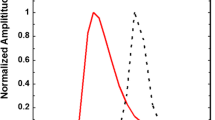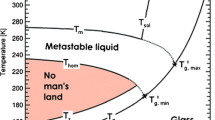ABSTRACT
Purpose
Phase separation of monoclonal antibody A (MAb A) solution and its relation to protein self-association are studied.
Methods
A phase diagram of MAb A and its dependence on ionic strength and pH were investigated. The protein self-associations were characterized by dynamic light scattering (DLS), analytical ultracentrifugation analysis (AUC) and viscosity measurement.
Results
MAb A solution with a clear appearance in an isotonic ionic strength condition turned opalescent in a low ionic strength condition, followed by liquid-liquid phase separation (LLPS) into light and heavy phases. The protein concentrations of the two phases were dependent on the ionic strength and pH. The two phases became reversibly miscible when the ionic strength or temperature was increased. DLS and AUC showed that MAb A under a low ionic strength condition self-associates at a protein concentration above the critical concentration of 16.5 mg/mL. The viscosity of the heavy phase was high and dependent on the shear rate. These results indicate that attractive protein-protein interaction in the heavy phase induces LLPS.
Conclusions
LLPS was induced in MAb A solution in a low ionic strength condition due to reversible protein self-association mediated mainly by attractive electrostatic interaction among the MAb A molecules in the heavy phase.









Similar content being viewed by others
REFERENCES
Shire SJ, Shahrokh Z, Liu J. Challenges in the development of high protein concentration formulations. J Pharm Sci. 2004;93:1390–402.
Minton AP. Molecular crowding: analysis of effects of high concentrations of inert consolutes on biochemical equilibria and rates in terms of volume exclusion. Methods Enzymol. 1998;295:127–49.
Jiménez M, Rivas G, Minton AP. Quantitative characterization of weak self-association in concentrated solutions of immunoglobulin G via the measurement of sedimentation equilibrium and osmotic pressure. Biochemistry. 2007;46:8373–8.
Demeule B, Lawrence MJ, Drake AF, Gurny R, Arvinte T. Characterization of protein aggregation: the case of a therapeutic immnoglobulin. Biochem Biophys Acta. 2007;1774:146–53.
Liu J, Nguyen MDH, Andya JD, Shire SJ. Reversible self-association increases the viscosity of a concentrated monoclonal antibody in aqueous solution. J Pharm Sci. 2005;94:1928–40.
Saluja A, Badkar AV, Zeng DL, Nema S, Kalonia DS. Application of high-frequency rheology measurements for analyzing protein-protein interactions in high concentration solutions using a model antibody (IgG2). J Pharm Sci. 2006;95:1967–83.
Chari R, Jerath K, Badkar AV, Kalonia DS. Long- and short-range electrostatic interactions affect the rheology of highly concentrated antibody solutions. Pharm Res. 2010;26:2607–18.
Saluja A, Kalonia DS. Nature and consequences of protein-protein interactions in high protein concentration solutions. Int J Pharm. 2008;358:1–15.
Cromwell MEM, Felten C, Flores H, Liu J, Shire SJ. Self-association of therapeutic proteins: Implications for product development. In: Murphy RM, Tsai AM, editors. Misbehaving proteins: protein misfolding, aggregation, and stability, New York: Springer; 2006. pp 313–330.
Cleland JL, Powell MF, Shire SJ. The development of stable protein formulations: a close look at protein aggregation, deamidation and oxidation. Crit Rev Ther Drug Carr Syst. 1993;10:307–77.
Braun A, Kwee L, Labow MA, Alsenz J. Protein aggregates seem to play a key role among the parameters influencing the antigenicity of interferon alpha (INF-alpha) in normal and transgenic mice. Pharm Res. 1997;14:1472–8.
Hermeling S, Crommelin DJ, Schellekens H, Jiskoot W. Structure-immunogenicity relationships of therapeutic proteins. Pharm Res. 2004;21:897–903.
Robert D, Barelli S, Crettaz D, Bart PA, Schifferli JA, Betticher D et al. Clinical proteomics: study of a cryogel. Proteomics. 2006;6:3958–60.
Yagi H, Takahashi N, Yamaguchi Y, Kato K. Temperature-dependent isologous Fab-Fab interaction that mediates cryocrystallization of a monoclonal immunoglobulin G. Mol Immunol. 2004;41:1211–5.
Narayanan J, Liu XY. Protein interactions in undersaturated and supersaturated solutions: a study using light and X-ray scattering. Biophys J. 2003;84:523–32.
Salinas BA, Sathish HA, Bishop SM, Harn N, Carpenter JF, Randolph TW. Understanding and modulating opalescence and viscosity in a monoclonal antibody formulation. J Pharm Sci. 2010;99:82–93.
Yadav S, Liu J, Shire SJ, Kalonia DS. Specific interactions in high concentration antibody solutions resulting in high viscosity. J Pharm Sci. 2010;99:1151–68.
Saluja A, Badkar AV, Zeng DL, Nema S, Kalonia DS. Ultrasonic storage modulus as a novel parameter for analyzing protein-protein interactions in high protein concentration solutions: correlation with static and dynamic light scattering measurements. Biophys J. 2007;92:234–44.
Saluja A, Kalonia DS. Application of ultrasonic shear rheometer to characterize rheological properties of high concentration solutions at microliter volume. J Pharm Sci. 2005;94:1161–8.
Saluja A, Badkar AV, Zeng DL, Kalonia DS. Ultrasonic rheology of a monoclonal antibody (IgG2) solution: implications for physical stability of proteins in high concentration formulations. J Pharm Sci. 2007;96:3181–95.
Patel AR, Kerwin BA, Kanapuram SR. Viscoelastic characterization of high concentration antibody formulations using quartz crystal microbalance with dissipation monitoring. J Pharm Sci. 2009;98:3108–16.
Kanai S, Liu J, Patapoff TW, Shire SJ. Reversible self-association of a concentrated monoclonal antibody solution mediated by Fab-Fab interaction that impacts solution viscosity. J Pharm Sci. 2008;97:4219–27.
Sukumar M, Doyle BL, Combs JL, Pekar AH. Opalescent appearance of an IgG1 antibody at high concentrations and its relationship to noncovalent association. Pharm Res. 2004;21:1087–93.
Annunziata O, Asherie N, Lomakin A, Pande J, Ogun O, Benedek GB. Effect of polyethylene glycol on the liquid-liquid phase transition in aqueous protein solutions. Proc Natl Acad Sci USA. 2002;99:14165–70.
Asakura S, Oosawa F. On interactions between two bodies immersed in a solution of macromolecules. J Chem Phys. 1954;22:1255–6.
Jion AI, Goh LT, Oh SKW. Crystallization of IgG1 by mapping its liquid-liquid phase separation curve. Biotech Bioeng. 2006;95:911–8.
Ahamed T, Esteban BNA, Ottens M, van Dedem GW, van der Wielen LA, Bisschops MAT et al. Phase behavior of an intact monoclonal antibody. Biophy J. 2007;93:610–9.
Dumets AC, Chockla AM, Kaler EW, Lenhoff AM. Protein phase behavior in aqueous solutions: crystallization, liquid-liquid phase separation, gels, and aggregates. Biophys J. 2008;94:570–83.
Haruyama H, Ito S, Miyadai K, Takahashi T, Kawaida R, Takayama T et al. Humanization of the mouse anti-Fas antibody HFE7A and crystal structure of the humanized HFE7A Fab fragment. Biol Pharm Bull. 2002;25:1537–45.
Thomson JA, Schurtenberger P, Thurston GM, Benedek GB. Binary liquid phase separation and critical phenomena in a protein/water solution. Proc Natl Acad Sci USA. 1987;84:7079–83.
Baek SG, Magda JJ. Monolithic rheometer plate fabricated using silicon micromachining technology and containing miniature pressure sensors for N 1 and N 2 measurements. J Rheology. 2003;47:1249–60.
Pipe C, Kim NJ, McKinley G. Microfluidic Rheometery on a Chip. 2007 4th AERC, Italy
Schuck P. Size distribution analysis of macromolecules by sedimentation velocity ultracentrifugation and Lamm equation modeling. Biophys J. 2000;78:1606–19.
Tanaka T, Ishimoto C. Phase separation of a protein-water mixture in cold cataract in the young rat lens. Science. 1977;197:1010–2.
Ishimoto C, Tanaka T. Critical behavior of a binary mixture of protein and salt water. Phys Rev Lett. 1977;39:474–7.
Kato K, Sautes-Fridman C, Yamada W, Kobayashi K, Uchiyama S, Kim H et al. Structural basis of the interaction between IgG and Fcγ receptors. J Mol Biol. 2000;295:213–24.
Oda M, Uchiyama S, Noda M, Nishi Y, Koga M, Mayanagi M et al. Effects of antibody affinity and antigen valence on molecular forms of immune complexes. Mol Immunol. 2009;47:352–64.
Liu J, Andya JD, Shire SJ. A critical review of analytical ultracentrifugation and field flow fractionation methods for measuring protein aggregation. AAPS J. 2006;8:E580–9.
Pekar A, Sukumar M. Quantitation of aggregates in therapeutic proteins using sedimentation velocity analytical ultracentrifugation: practical considerations that affect precision and accuracy. Anal Biochem. 2007;367:225–37.
George A, Wilson WW. Predicting protein crystallization from a dilute solution property. Acta Crystallogr A. 1994;D50:61–365.
George A, Chiang Y, Guo B, Arabshahi A, Cai Z, Wilson WW. Second virial coefficient as predictor in protein crystal growth. Methods Enzymol. 1997;276:100–10.
Clark JI, Clark JM. Lens cytoplasmic phase separation. Int Rev Cytol. 2000;192:171–87.
Cromwell MEM, Carpenter JF, Scherer T, Randolph TW. Opalescence in antibody formulations is a solution critical phenomenon. Abstracts of Papers. 2008 236th ACS National Meeting, Philadelphia, PA, United States.
Cromwell MEM. Implications of phase separation on pharmaceutical development. 2009 AAPS National Biotechnology Conference, Seattle, WA, United States.
McDonald P, Victa C, Carter-Franklin JN, Fahrner R. Selective antibody precipitation using polyelectlyte: A novel approach to the purification of monoclonal antibodies. Biotech Bioeng. 2009;102:1141–51.
Matheus S, Friess W, Schwartz D, Mahler HC. Liquid high concentration IgG1 antibody formulations by precipitation. J Pharm Sci. 2009;98:3043–57.
Strandner A, Sedgwick H, Cardinaux F, Poon WCK, Egelhaaf SU, Schurtenberger P. Equilibrium cluster formation in concentrated protein solutions and colloids. Nature. 2004;432:492–5.
ACKNOWLEDGEMENTS
We would like to thank Mr. Yuichi Shinozaki and Ms. Tazuko Watanabe (Anton Paar Japan K.K.) for the viscosity measurements.
Author information
Authors and Affiliations
Corresponding author
Electronic supplementary material
Fig. S1
Effect of polysorbate 80 concentation on the protein concentation in the light (●) and heavy (▲) phases at 25°C in low ionic strength buffer of 5 mM sodium phosphate, 10 mM sodium phosphate, 10 mM sodium chloride, 5% sucrose, pH 5.5 N = 3 (GIF 221 kb)
Fig. S2
Visual appearance of MAb A solution a) at 53 mg/mL and b) at 107 mg/ml in low ionic strength buffer of 5 mM sodium phosphate, 10 mM sodium chloride, 5% sucrose, pH 5.5 at ambient temperature (GIF 372 kb)
Fig. S3
Autocorrelation function obtained in DLS measurement of MAb A in isotonic ionic strength condition of 10 mM sodium phosphate, 140 mM sodium chrolide, pH 7.2 (GIF 207 kb)
Fig. S4
SEC chromatogram of MAb A before (red line) and after (Blue line) LLPS (GIF 192 kb)
Rights and permissions
About this article
Cite this article
Nishi, H., Miyajima, M., Nakagami, H. et al. Phase Separation of an IgG1 Antibody Solution under a Low Ionic Strength Condition. Pharm Res 27, 1348–1360 (2010). https://doi.org/10.1007/s11095-010-0125-7
Received:
Accepted:
Published:
Issue Date:
DOI: https://doi.org/10.1007/s11095-010-0125-7




